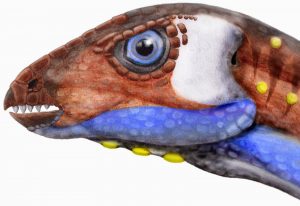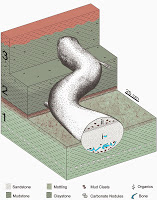
A unique burrowing dinosaur that cared for its young in dens will be featured in a new exhibit opening Saturday, Nov. 22, at Montana State University’s Museum of the Rockies.
Discovered in southwest Montana and eastern Idaho, the adult Oryctodromeus would have been the size of a golden retriever but its long tail made it about seven feet long, said MSU paleontologist David Varricchio, whose findings and those of his graduate students inspired the “Burrowing Dinosaurs” exhibit.
“It’s really bizarre. I never would have thought of a burrowing dinosaur,” said Pat Leiggi, administrative director of paleontology and director of exhibits at the museum. “What’s cool about it is that it is the first occurrence of a burrowing or denning dinosaur. It’s new. It’s unique.”
Former MSU grad student Yoshihiro Katsura found the first remains 10 years ago while prospecting on public land about 15 miles from Lima, Mont. The fact that an adult and two juvenile Oryctodromeus were jumbled together in a burrow was significant, Varricchio said in a 2007 paper published by the British scientific journal, Proceedings of the Royal Society B.
“The presence of an adult and two juveniles within a denning chamber represents some of the best evidence for dinosaur parental care,” Varricchio wrote. “The burrow likely protected the adult and young Oryctodromeus from predators and harsh environmental conditions.”
The Oryctodromeus lived 95 million years ago. That’s 20 to 30 million years before the more familiar dinosaurs of prehistoric Montana, Varricchio said. The Hell Creek Formation of eastern Montana, for example, holds 65-million-year-old Tyrannosaurus rex skeletons. The Two Medicine Formation near Choteau yielded 75-million-year-old dinosaur eggs and babies.

The Oryctodromeus that Varricchio and MSU doctoral student L.J. Krumenacker now study came from the Blackleaf Formation of southwest Montana and the Wayan Formation of eastern Idaho.
The “Burrowing Dinosaurs” exhibit will show a cross section of the dinosaur’s burrow with two juveniles and an adult inside of it, Leiggi said. It will also contain a small rodent in a separate area of the burrow. At the top entrance of the burrow will be an adult Lull-mounted Oryctodromeus. A Lull mount is a model that shows a skeleton on one half and a flesh-covered version on the other. On the lower right-hand side of the burrow will be a partially reconstructed oviraptor egg clutch and a cast of the two oviraptor eggs that were discovered nearby.
The new exhibit will sit in the museum’s Hall of Giants where a Titanosaur and two Deinonychus dinosaurs were displayed, Leiggi said. Those fossils will be sent in January to a sister institution, the Fukui Prefectural Dinosaur Museum in Katsuyama, Japan.
“The Siebel Dinosaur Complex was designed to change as we learn new things about dinosaurs,”Leiggi said. “This is a great example of that, what we are trying to accomplish.”
Krumenacker, who has been working more than a decade at the Idaho field site, said that field work is much easier for him than helping create an exhibit. He is excited about the opportunity, however.
“I have never gotten to help with something like this,” Krumenacker said. “It’s nice to see the dinosaur you are working on put together.”
The public will see an accurate picture of the Oryctodromeus, because – between the sites in Montana and Idaho—the researchers found almost every part of the burrowing dinosaur, Krumenacker said. All that’s missing are its fingertips and pieces of its head.
Varricchio said he, too, is looking forward to sharing the burrowing dinosaurs in a Museum of the Rockies exhibit. Although he now works out of Traphagen Hall and Gaines Hall on the MSU campus, he spent a lot of time at the museum as a graduate student and later as collection manager.
Note : The above story is based on materials provided by Montana State University










